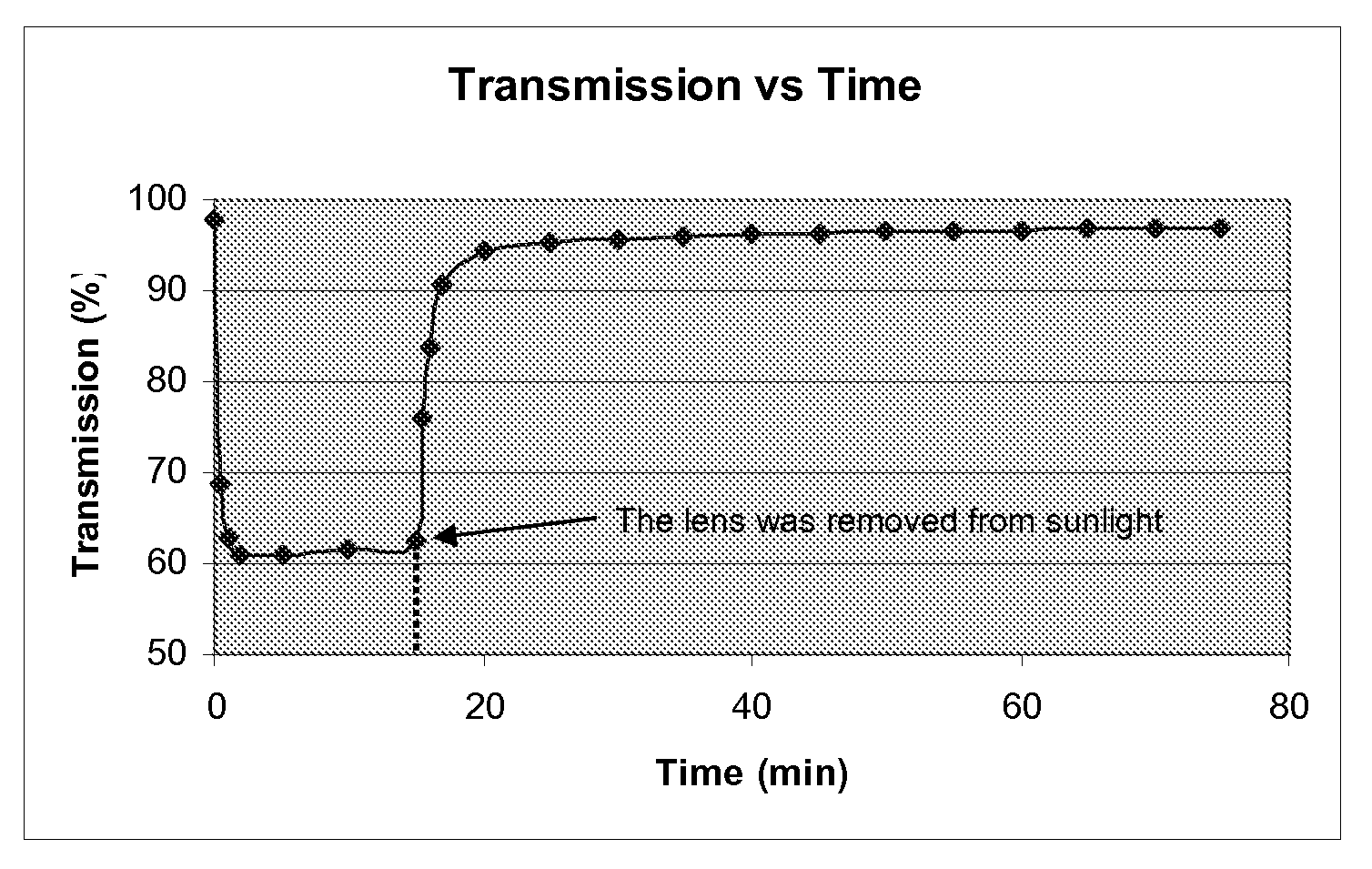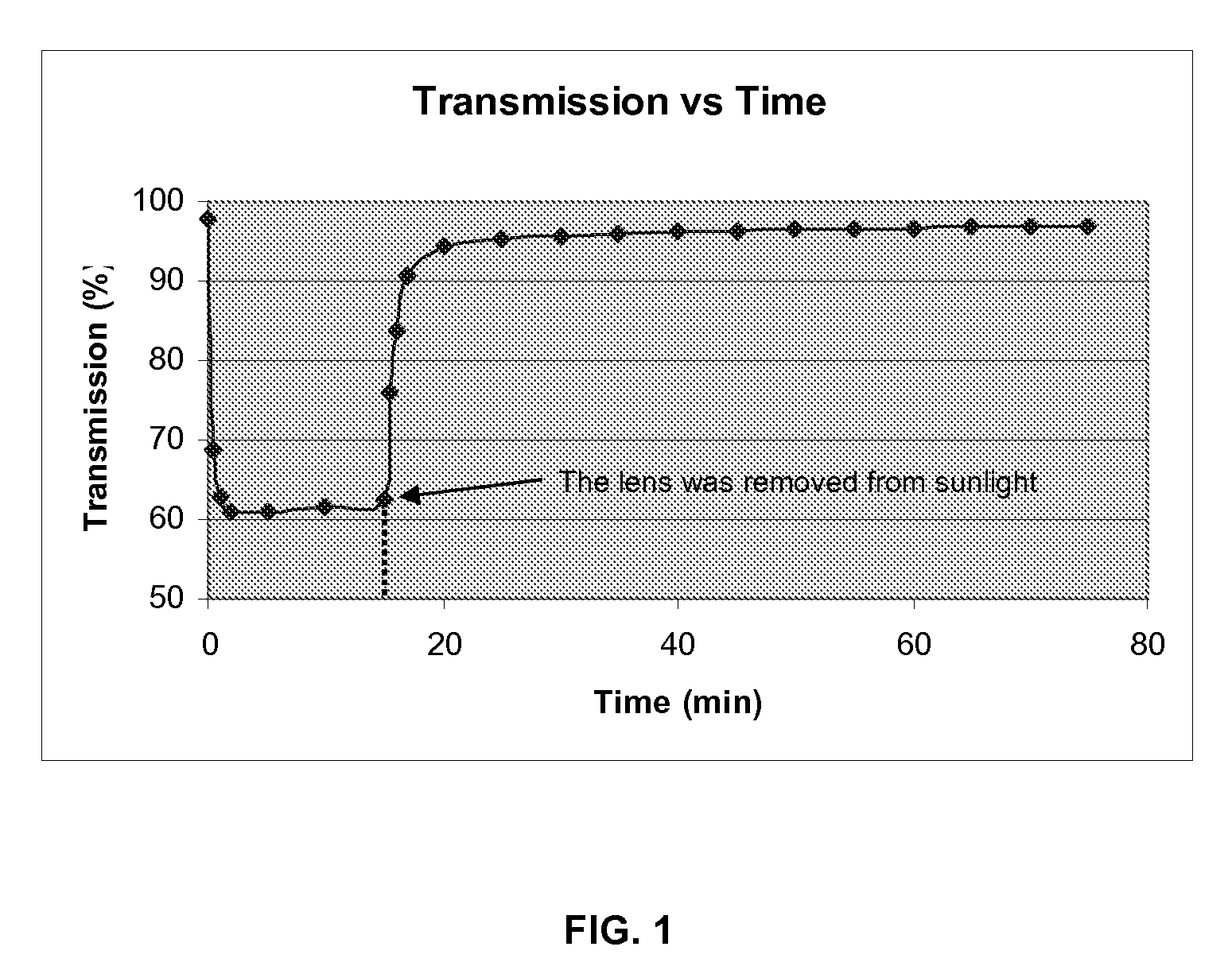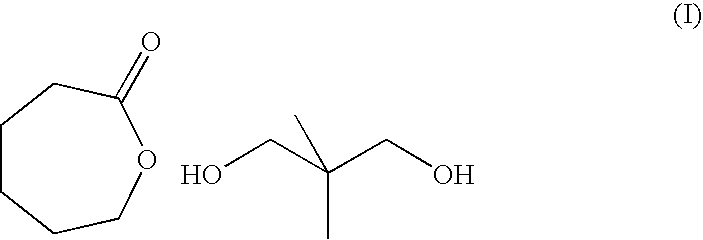Abrasion and/or Scratch Resistant Article Comprising an Impact Resistant Photochromic Polyurethane Coating, and Process of Preparation Thereof
- Summary
- Abstract
- Description
- Claims
- Application Information
AI Technical Summary
Benefits of technology
Problems solved by technology
Method used
Image
Examples
example 1
Preparation of an Unblocked NCO Terminated Polyurethane Pre-Polymer According to the Invention
[0200]A 1 liter glass reactor with a separate 3 neck top was charged with 142.87 g of the polyester diol CAPA® 2100A (142 mmol). CAPA® 2100A being a wax like material at room temperature, it was necessary to warm this compound to 60° C. to reduce the viscosity so that it could be charged to the reaction vessel under a liquid form. A heating mantle was used as the source of heat and a condenser was attached to a chiller set at 10° C. The system was constantly supplied with inert gas (dry nitrogen).
[0201]76.1 g of dicyclohexylmethane-4,4′-diisocyanate (Desmodur W®, 290 mmol, molar ratio of NCO / OH=2.04) were added to the vessel and the heating mantle temperature was set to 105° C. The reaction was monitored by checking the refractive index and observing the elimination of the —OH peak by FT-IR. It could be seen from the data that the refractive index levels off after 1 hour, indicating that th...
examples 2 to 5
Preparation of Ophthalmic Lenses Coated with an Impact Resistant Photochromic Film According to the Invention
[0203]For those experiments, a Headway was used as a spin coater and a LESCO EZ-IR curing system (FBM1004) was used as a curing system. Table 1 indicates the curing temperature (temperature of the lens surface measured with Omegascope OS531) as a function of the curing time and curing system setting. The lenses can be placed in the LESCO EZ-IR curing system set at 575, 700, 725 or 800° C. (IR temperature) for 45, 90, 135 or 180 seconds. Grey colored cells correspond to lenses prepared according to the process of the invention.
TABLE 1
example 2
[0204]Coating compositions were prepared in the following manner. The pre-polymer of example 1 (5.45 g) was mixed with THF (4.55 g). Then, the catalyst dibutyltin dichloride (DBTDC, 0.07 g for example 2.1, 0.15 g for example 2.2), photochromic dye 7-120 (0.0114 g for example 2.1, 0.114 g for example 2.2) and photochromic dye 7-176 (0.0070 g) were added and mixed until dissolved. A small amount of heat (heat gun) was required to dissolve dyes into the solution. A solution comprising the polyester triol CAPA® 3050 (1.92 g, molar ratio of NCO / OH=1) and THF (0.95 g) was added to the coating composition and sonication was used to remove bubbles.
[0205]Both prepared coating compositions were each spin coated (500 rpm for 10 s increased to 1000 rpms for 30 s) onto clean CR-39® piano lenses. The lenses were placed in the LESCO EZ-IR curing system set at 700° C. for 45 or 90 seconds.
[0206]It was observed that the prepared polyurethane coatings were still tacky (to the touch). Those lenses wer...
PUM
| Property | Measurement | Unit |
|---|---|---|
| Temperature | aaaaa | aaaaa |
| Temperature | aaaaa | aaaaa |
| Temperature | aaaaa | aaaaa |
Abstract
Description
Claims
Application Information
 Login to View More
Login to View More - Generate Ideas
- Intellectual Property
- Life Sciences
- Materials
- Tech Scout
- Unparalleled Data Quality
- Higher Quality Content
- 60% Fewer Hallucinations
Browse by: Latest US Patents, China's latest patents, Technical Efficacy Thesaurus, Application Domain, Technology Topic, Popular Technical Reports.
© 2025 PatSnap. All rights reserved.Legal|Privacy policy|Modern Slavery Act Transparency Statement|Sitemap|About US| Contact US: help@patsnap.com



